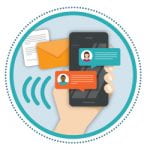What are the key things I need to know and do?
You can complete Message Testing with audiences in your school or district in four steps. From learning key concepts to understanding the who, what, and how of effective messaging – it is all available here. Be sure to read the St. Louis case study to see how others have used Message Testing to support efforts to build a culture of health and well-being.

 1. Learn key concepts
1. Learn key concepts
Before you start, take some time to learn about the who (messengers), what (messages), and how (strategies) of effective messaging. These elements are critical if you want to create messages that generate buy-in for a healthy school.
 2. Understand who are your messengers
2. Understand who are your messengers
The first step is to identify people in your school or district who are effective messengers. Usually, these messengers fill a few different roles that tend to be go-to sources of information. You will also learn about ways to identify specific individuals who can be your messengers.
 3. Identify what messages resonate with your audience
3. Identify what messages resonate with your audience
After you have identified your messengers, you can begin to select messages that will generate buy-in and action for creating healthy schools. You can use messages that have worked in other schools and districts, or you can use techniques to customize messages for your school or district.
 4. Determine how to reach your audience
4. Determine how to reach your audience
Many strategies can help ensure your messages reach your audience and have the impact that you want. You will learn about some general approaches to messaging in schools and districts as well as techniques to customize strategies for your school or district.
 6. Read about this work in St. Louis
6. Read about this work in St. Louis
Read the case study to learn how a team of researchers, educators, and community partners in two school districts in the St. Louis region tested and refined messengers, messages, and messaging strategies that worked in their communities.
